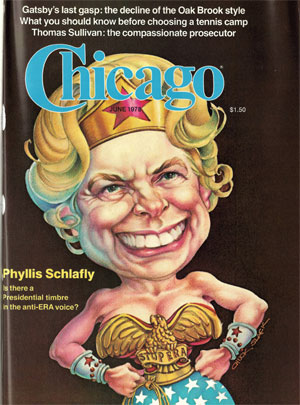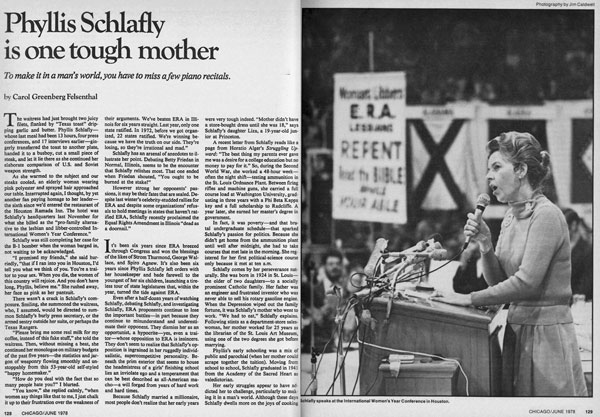
Anti-Equal Rights Amendment crusader and conservative activist Phyllis Schlafly, who, at least in my world, was one of the most hated women of the last century and this, died at home on Labor Day at age 92. I knew her on and off for the last 39 years, and when I was in her company, say doing an interview over lunch, I found her hard to hate. (My warm feelings would evaporate as soon as I saw her on television inveighing against the ERA.)
In 1977, as a rookie freelance writer, I wrangled an assignment from the book editor of the Chicago Tribune to review Schlafly's ninth book, The Power of the Positive Woman. Boy, did I ever hate it, and was it ever easy to tear it apart. Schlafly’s advice on “How to be a Happy Housewife” was, I thought, ridiculous. Her statement on what women really want: to fulfill “the overriding psychological need …to love something alive,” was, I thought, even worse. Her opinions, to me, seemed stupefyingly dense, as if she concocted them to deliberately insult women who were trying stake a place in the world of work: ''The great heroes of women's liberation are not the straggly haired women on television talk shows and picket lines, but Thomas Edison, who brought the miracle of electricity to our homes to give light and to run all those labor-saving devices.''
After my review—the most snarky, mean, and negative I had ever written before or since—was published in the summer of 1977, I was stunned by the reaction. My mailbox filled with letters covered with stickers “US out of the UN” (one of Schlafly's causes) and filled with scrawled, anti-Semitic vitriol (I guess my name gave me away).
I was so disgusted I remember putting on yellow rubber gloves when opening the letters lest some right-wing spittle infect me. But I soon became fascinated by the passion her fans brought to her defense. And I was impressed that she never complained to me or the newspaper.
I headed to the microfilm room of the Chicago Public Library to find out more about her life. That resulted in my writing a cover profile of Schlafly for Chicago magazine, and then a full-fledged biography, my first book.
The book, The Sweetheart of the Silent Majority, was published in 1981. Along the way, I had many conversations, arguments, meetings with Schlafly—all civil, even friendly, but none of them comfortable. I was chatting with a woman with whom I could not have been more in disagreement.
Her reasons for opposing the ERA seemed, at the time, farfetched. They seemed to camouflage her real purpose: her anti-communism zealotry, her belief in the grandeur of nuclear weapons (the atomic bomb, she said, was “a marvelous gift given to our country by a wise God”), and her work to send men to the White House whom she believed would bury once and for all the wishy-washy Ike/Rockefeller Republicans she so detested.
She told me that, in 1971, when a friend asked her to speak against the proposed ERA, she had little interest in it, and, if pressed, would have said she was sort of for it. She saw it, she said, “as something between innocuous and mildly helpful.” Not for long, She read into it, all manner of, in her opinion, potential horrors—men marrying men, women marrying women, unisex toilets, the end of Girl Scouts and single-sex schools, women being drafted into combat.
I spent days downtown with unwieldy microfilm and malfunctioning readers slowly reaping facts and insight into my subject.
I learned that she had run for Congress in 1952—local Republicans had asked her husband, Fred, to run in the Republican primary and turned to her when he declined. She pulled an upset, but even so was patronized and diminished by local media. The St. Louis Post-Dispatch, for example, described her as a “powder puff” candidate and the Globe-Democrat ran a photo of her in a frilly apron frying an egg for Fred’s breakfast: “She doesn’t let political successes interfere with her wifely duties.” Not surprisingly, she lost to the popular incumbent Democrat in the heavily Democratic district in the general election.
Her critics would not recognize the 1952 edition of Schlafly. “Women belong in the House—the U.S. House of Representatives” was her slogan.
My research and later scores of interviews, led me to believe that what Schlafly wanted most was a seat at the table with the big boys of foreign policy and nuclear strategy. In a general election debate during that run for Congress, while her opponent spoke in generalities, she spoke in specifics: The U.S. should blockade the coast of China and bomb the bridges on the Yalu River; she offered a mind-numbing comparison of Russian MiG jet fighters to American Sabres.
Would she have liked to be Secretary of State or Secretary of Defense? Definitely.

Soon after I signed the contract to write her biography, I called her, and she eventually invited me to the limestone Tudor mansion overlooking the bluffs of the Mississippi River in Alton, Illinois, where she lived with Fred and their six children.
She made lunch and she explained that she cared very much about the food her family ate. She told me that she would get up early to buy eggs and milk fresh from the farm. She was into organic food when it was still a kind of crank pursuit. She gushed about the wild rice that we ate, the process of getting it and preparing it. Nothing like the store-bought variety, she said, which should be avoided at all costs.
Noticing that I looked tired—I feared missing my morning flight and so stayed up all night—she said she didn’t require much sleep and shared the “secret” of her “success,” the cat nap. She added that she was following in the footsteps of Albert Einstein.
She asked me that afternoon how my family practiced Judaism and seemed surprised when I said I was not at all observant and that I had been turned off by the synagogue experience of my youth and would be happy never to attend another High Holiday service. She told me that I’d change my mind once I had children, and, by the way, when did my husband and I plan to have them?
My first child was born shortly before my Schlafly biography was published. A week or two after the birth, Schlafly and I were invited to appear on a WGN radio show—my husband remembers it as Milt Rosenberg’s show. The topic was not the ERA, a subject I knew up, down, and sideways, but, as I recall it, nuclear throw weights. I may be exaggerating the technical level of the subject, but it was within that range of intimidating—especially to someone like me who doesn’t completely understand how electricity works.
I was breastfeeding every hour on the hour, night and day, practically drooling with exhaustion. My husband accompanied me to the studio, and I could hear my daughter howling with hunger while I was deservedly sidelined and ignored in the discussion, but forced to stay put until the program ended.
Later I nursed the baby in the station’s cafeteria and she came in and sat down with us, causing me acute embarrassment. Not only did I find it totally weird to nurse in front of Phyllis Schlafly—who said frequently that she had nursed all six of her children each for I forget how many months—nursing wasn’t going well for me, and my baby, for a time, was losing weight instead of gaining.
After five minutes or so, she opened her bag and pulled out a beautifully wrapped gift—a sterling silver spoon for our newborn. I was shocked and felt that it was wrong to accept it, but I did. I decided that I was going to use it, not display it. Once the baby started to eat rice cereal, I used that spoon. Before long, I neglected to replace the drain cover in the sink, and the beautiful spoon fell down into the jaws of the disposal and was noisily crushed.
While writing the book, I became friendly with a former president of National Organization for Women, the late Karen DeCrow. She told me that while utterly disagreeing with Schlafly, she grew fond of her. She and Schlafly had an ongoing paid gig. They were hired to throw fastballs at each other, mostly in front of college audiences. Before taking the stage, DeCrow recalled, they’d stand beside each other in the schools’ ladies rooms refreshing their makeup and laughing about politicians and activists, and others they knew in common. DeCrow told me she was in “kind of a bind about Phyllis,” finding her positions on issues “dreadful and dangerous” but she called Schlafly strong, tough, and extremely liberated. DeCrow liked to joke, “If I had a daughter I would want her to be a housewife, just like Phyllis Schlafly.”
I had read that Schlafly had cancer. A better person might have written her a note, but I did not. Then I heard about trouble in the Eagle Forum over Schlafly’s decision to back Donald Trump instead of Ted Cruz. I was surprised because Cruz would have seemed like her kind of guy, and the thrice-married Trump definitely not. But she feared that Cruz would turn out to be a more conventional Republican once he took the White House and, she, long before anyone had ever heard of Donald Trump, believed that the system was “rigged” by “secret kingmakers” who installed the kind of country club Republicans she spent a career opposing.
Oh, to be able to hear or read her response on November 8 when Hillary Clinton defeats Donald Trump. Schlafly, a true believer if ever there was one, would have been certain, until the polls closed, that the Donald was soon to become President Trump. A younger, healthier Phyllis Schlafly would have had, perhaps, a place in his administration.


